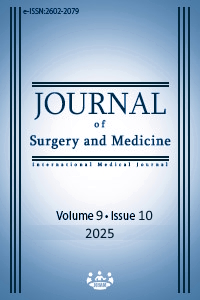Medical error tendency levels and associated factors in surgical nurses from different generations
Tendency to medical error levels and associated factors
Keywords:
surgical nurse, medical error, generational (Y, Z) difference, patient safety, nursing workforceAbstract
Background/Aim: Since experience is acquired over time, characteristics deriving from intergenerational differences play an important role in medical errors. This study was performed to determine tendency to medical error levels and associated factors in surgical nurses from two different generations (Y and Z).
Methods: This cross-sectional, correlational study was conducted with 168 nurses working in a public and a training and research hospital between 1 May and 30 June, 2023, and selected using the random sampling method. A sociodemographic data form and the Medical Error Tendency Scale were employed for data collection. The data analysis was performed with number, percentage, and mean values and using Student’s t test, ANOVA, and Pearson’s correlation analysis.
Results: Seventy-two percent of the nurses were from Generation Y. Mean tendency to medical error scores were 231.23 (11.25) in the nurses from Generation Y and 225.59 (11.76) in those from Generation Z. The difference in mean total Medical Error Tendency Scale scores between the two generations was statistically significant (P=0.005). A significant difference in favor of Generation Y was observed in the Medical Error Tendency Scale ‘drug and transfusion practices’ (P=0.006), ‘prevention of infections’ (P=0.004), and ‘patient monitoring and equipment safety’ subdimensions (P=0.008). Nurses who enjoyed working in their clinics and who had sufficient sleep status also registered higher mean Medical Error Tendency Scale scores (P<0.05).
Conclusions: The nurses in this study exhibited a moderate tendency to medical error, the difference between the two groups being significantly in favor of Generation Y. Enjoying their work and sufficient sleep status had a positive effect on nurses’ performance by reducing their tendency to medical error.
Downloads
References
The Joint Commission, 2010. Available from: https://www.jointcommission.org/about/jointcommissionfaqs.aspx?faq#324. Accessed: 20 October 2023.
Ta'an W. Medical error prevalence, nursing power, and structural empowerment: A serial mediation analysis. Scientific World Journal. 2024;1554373. doi: 10.1155/2024/1554373. DOI: https://doi.org/10.1155/2024/1554373
Gaffney TA, Hatcher BJ, Milligan R. Nurses' role in medical error recovery: an integrative review. J Clin Nurs. 2016;25(7-8):906-17. doi: 10.1111/jocn.13126. DOI: https://doi.org/10.1111/jocn.13126
Ertem G, Oksel E, Akbıyık A. Hatalı tıbbi uygulamalar (malpraktis) ile ilgili retrospektif bir inceleme. Dirim Tıp Dergisi. 2009;84(1):1-10.
Turkish Ministry of Health. GRS Güvenlik raporlama sistemi 2016 yılı istatistik ve analiz raporu, 2016. Available from: http://grs.saglik.gov.tr/BM/Reports/GRS2016rapor_R1.pdf. Accessed: 22 April 2023.
Kalra J, Kalra N, Baniak N. Medical error, disclosure and patient safety: a global view of quality care. Clin Biochem. 2013;46(13-14):1161-9. doi: 10.1016/j.clinbiochem.2013.03.025. DOI: https://doi.org/10.1016/j.clinbiochem.2013.03.025
Oliveira AC, Garcia PC, Nogueira LS. Nursing workload and occurrence of adverse events in intensive care: a systematic review. Rev Esc Enferm USP. 2016;50(4):683-94. doi: 10.1590/S0080-623420160000500020. DOI: https://doi.org/10.1590/S0080-623420160000500020
Al-Kandari F, Thomas D. Adverse nurse outcomes: correlation to nurses’ workload, staffing, and shift rotation in Kuwaiti hospitals. Applied Nursing Research. 2008;21:139-46. DOI: https://doi.org/10.1016/j.apnr.2006.10.008
Özata M, Altunkan H. Frequency of medical errors in hospitals, determination of medical error types and medical errors: Konya sample. Medical Research Journal. 2010;8(2):100-11.
Mauti G, Githae M. Medical error reporting among physicians and nurses in Uganda. Afr Health Sci. 2019;19(4):3107-17. doi: 10.4314/ahs.v19i4.33. DOI: https://doi.org/10.4314/ahs.v19i4.33
Mohsenpour M, Hosseini M, Abbaszadeh A, Shahboulaghi FM, Khankeh H. Nursing error: an integrated review of the literature. Indian J Med Ethics. 2017;2(2):75-81. doi: 10.20529/ijme.2017.020. DOI: https://doi.org/10.20529/IJME.2017.020
Dikmen DY, Yorgun S, Yeşilçam N. Hemşirelerin tıbbi hatalara eğilimlerinin belirlenmesi. Hacettepe Üniversitesi Hemşirelik Fakültesi Dergisi. 2014;32(1):44-56.
So Hee L, Yeojin Y. Work values and communication styles among Generation X, Y, and Z nurses: A cross-sectional study. Int Nurs Rev. 2024;71(1):115-21. doi: 10.1111/inr.12863. DOI: https://doi.org/10.1111/inr.12863
Şenturan Ş, Köse A, Dertli E, Başak S, Şentürk N. X ve Y kuşağı yöneticilerinin iş değerleri algısı ve farklılıkları üzerine inceleme. Business & Economics Research Journal. 2016;7(3):171-82. DOI: https://doi.org/10.20409/berj.2016321815
Tan SHE, Chin GF. Generational effect on nurses' work values, engagement, and satisfaction in an acute hospital. BMC Nurs. 2023;22(1):88. doi: 10.1186/s12912-023-01256-2. DOI: https://doi.org/10.1186/s12912-023-01256-2
Grubb VM. The new workplace reality. In clash of the generations. Hoboken, NJ, USA: John Wiley & Sons, 2016. DOI: https://doi.org/10.1002/9781119220640
Haydari SM, Kocaman G, Tokat MA. Farklı kuşaklardaki hemşirelerin işten ve meslekten ayrılma niyetleri ile örgütsel ve mesleki bağlılıklarının incelenmesi. Sağlık ve Hemşirelik Yönetimi Dergisi. 2016;3(3):119-31.
Işık Andsoy I, Kar G, Öztürk Ö. Hemşirelerin tıbbi hata eğilimlerine yönelik bir çalışma. Sağlık Bilimleri Ve Meslekleri Dergisi. 2015;1(1):17-27. doi: 10.17681/hsp.06267. DOI: https://doi.org/10.17681/hsp.06267
Yüksel A, Akbulut T, Bahadır Yılmaz E. Hemşirelerde stresle baş etme ve tıbbi hataya eğilim düzeyleri arasındaki ilişkinin belirlenmesi. Sağlık Akademisyenleri Dergisi. 2016;6(4):288-94.
Karacabay K, Savcı A, Çömez S, Çelik N. Cerrahi hemşirelerinin iş yükü algilari ile tıbbi hata eğilimleri arasindaki ilişkinin belirlenmesi. Mersin Üniversitesi Sağlık Bilimleri Dergisi. 2020;13(3):404-17. DOI: https://doi.org/10.26559/mersinsbd.686481
Şahin ZA, Özdemir FK. Hemşirelerin tıbbi hata yapma eğilimlerinin incelenmesi. Hemşirelikte Eğitim ve Araştırma Dergisi. 2015;12(3):210-4.
Kandemir A, Yüksel S. Cerrahi hemşirelerinin tıbbi hata tutum ve eğilimlerinin belirlenmesi. Anadolu Hemşirelik ve Sağlık Bilimleri Dergisi, 2020;23(2):287-9. DOI: https://doi.org/10.17049/ataunihem.659960
Topcu I, Turkmen AS, Sahiner NC, Savaser S, Sen H. Physicians' and nurses' medical errors associated with communication failures. J Pak Med Assoc. 2017;67(4):600-4.
Bilgic N, Altun S. Determination of nurses' tendency to medical error and the factors affecting this in the Turkish Republic of Northern Cyprus. J Pak Med Assoc. 2022;72(7):1335-9.
Stevanin S, Voutilainen A, Bressan V, Vehviläinen-Julkunen K, Rosolen V, Kvist T. Nurses' generational differences related to workplace and leadership in two European Countries. West J Nurs Res. 2020;42(1):14-23. DOI: https://doi.org/10.1177/0193945919838604
Huber P, Schubert HJ. Attitudes about work engagement of different generations-A cross-sectional study with nurses and supervisors. J Nurs Manag. 2019;27(7):1341-50. DOI: https://doi.org/10.1111/jonm.12805
Özen N, Onay T, Terzioğlu F. Hemşirelerin tıbbi hata eğilimlerinin ve etkileyen faktörlerin belirlenmesi. Sağlık Bilimleri ve Meslekleri Dergisi. 2019;6(2):283-92.
Arimura M, Imai M, Okawa M, Fujimura T, Yamada N. Sleep, mental health status, and medical errors among hospital nurses in Japan. Ind Health. 2010;48(6):811-7. DOI: https://doi.org/10.2486/indhealth.MS1093
Phillips LA, de Los Santos N, Ntanda H, Jackson J. The impact of the work environment on the health-related quality of life of Licensed Practical Nurses: a cross-sectional survey in four work environments. Health Qual Life Outcomes, 2022;20(1):44. DOI: https://doi.org/10.1186/s12955-022-01951-9
Dorrian J, Lamond N, van den Heuvel C, Pincombe J, Rogers AE, Dawson D. A pilot study of the safety implications of Australian nurses' sleep and work hours. Chronobiol Int. 2006;23(6):1149-63. DOI: https://doi.org/10.1080/07420520601059615
Labrague LJ. Pandemic fatigue and clinical nurses' mental health, sleep quality and job contentment during the covid-19 pandemic: The mediating role of resilience. J Nurs Manag. 2021;29(7):1992-2001. DOI: https://doi.org/10.1111/jonm.13383
Karagozoglu S, Bingöl N. Sleep quality and job satisfaction of Turkish nurses. Nurs Outlook. 2008;56(6):298-307.e3. DOI: https://doi.org/10.1016/j.outlook.2008.03.009
Downloads
- 288 233
Published
Issue
Section
How to Cite
License
Copyright (c) 2025 Aylin Aydın Sayılan, Selin Orhan, Nurşen Kulakaç, Neriman Akyolcu
This work is licensed under a Creative Commons Attribution-NonCommercial-NoDerivatives 4.0 International License.
















